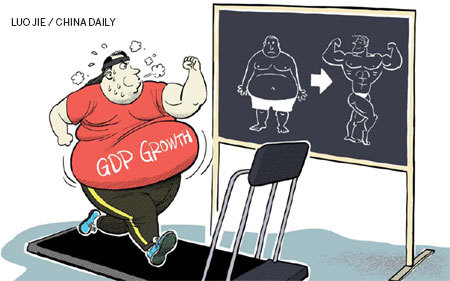Emphasis needs to be placed on helping the country's real economy, SMEs in particular, gain easier access to funds
The Third Plenary Session of the 18th National Congress of the Communist Party of China is expected to set the tone for new reforms in the coming years, and there are high expectations that it will signal further financial reforms.

To eliminate the structural imbalances in the country's financial sector will be a key issue in any financial reforms. Aside from the marketization of its interest and exchange rates, the emphasis should be on how to raise the efficiency of its financial resources distribution and how to help its real economic activities gain easier access to financial support.
China boasts a colossal stock of accumulated financial assets. However, a portion of these financial assets has not been fully utilized, with some of them sitting idle, due to an unreasonable structure and their maldistribution.
The country's current financial system, which is mainly based on banking loans, has given a helping hand to the development of its sprawling manufacturing and infrastructure sectors, but there has been insufficient financial support for high-tech, services and small and medium-sized enterprises. Due to their longstanding preference for large projects and large companies, China's banking loans have mainly flown to government-subsidized projects, State-owned or large-sized enterprises, and dominant traditional industries while leaving many small and less powerful companies, mostly privately-run, desperately hungry for funds. For example, the large amount of credit that has gone to real estate and government-sponsored investment projects has served as a factor behind the lackluster development of small and medium-sized manufacturers.

The irrational prosperity of financial products has also "squeezed" real economic activities. The rocketing social financing scale and a sharp rise in the volumes of off-balance-sheet financing and bonds financing since 2011 have been in sharp contrast with the continuous deceleration of the country's national economic growth and the downturn of its macroeconomic output. A large volume of additional currency supply has been injected into the market, but the lion's share has not entered the real economy. The direct consequence of this is the weakness of industrial production, manufacturing investment and commodities circulation. At the same time, the rising debt ratio and banks' hidden non-performing assets also pose huge risks.
Compared with a sharp rise in its monetary supply, the efficiency of the country's monetary output has been on a steep decline. China's overflowing currency supply since the eruption of the global financial crisis has directly resulted in its declining currency output efficiency. Even if some portion of these additional currency supplies have flowed to the real economy, how much influence they will produce on real economic activities will also depend on the pace of their circulation. Statistics indicate that the circulation pace of China's issued money since the global financial crisis has continually declined. The pace slowed from 0.63 in 2008 to 0.51 in 2012, a decline of nearly 20 percent. The slower pace of money circulation means the decreasing influence of its monetary inflation on economic output and efficiency.
All these highlight that future financial institutional reforms need to focus on developing a financial system that can effectively support the real economy and promote an optimized distribution system for its financial resources.
On the one hand, the country should regulate the speed of its credit expansion in a prudent manner and try to avoid the development of a debt-reliant economy. At the same time, it should take practical measures to accelerate marketization of its interest rates and security-based assets development, and promote direct financing and smooth channels for the circulation of social funds within the State financial system. On the other hand, effective measures should also be taken to optimize the country's financial structure and promote the transformation of its financial sector in tandem with its real economic transformation. To this end, the country should first give the green light to the establishment of small and medium-sized banking institutions that can better serve the large number of SMEs and micro-sized enterprises in the country. In many countries specialized financial agencies have been set up to offer credit support to small and medium-sized enterprises.
China should also try to promote the capitalization of its scientific research to make its financial resources more accessible to real economic activities. Instead of the financial system that was established in traditional industrial economic era, a modern financial system needs to be developed to facilitate the country's economic upgrading and industrial self-innovations.
The country should regard the establishment of such a financial system as a strategic task and embrace a series of preferential policies, such as fiscal input, research, credit and financing, to create a comprehensive financial system that can offer financial assistances to the development of the real economy.
The author is an economics researcher with the State Information Center.
(China Daily 11/04/2013 page8)